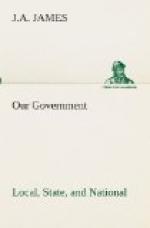4. How is the fact that conflicts between the authority of the Federal and the State courts do not arise, accounted for? Bryce, I, 234-235 (238).
5. Are the United States Courts influenced in their decisions by politics? Bryce, I, 259-261 (265-267).
6. Define treason and the punishment therefore. Constitution, Art. III, Sec. 3, Clauses 1 and 2. See Government in State and Nation, 268, 269.
7. Describe the influence of John Marshall as Chief Justice.
(a.) John Marshall, American Statesmen Series, Chapters X and XI.
(b.) Bryce, I, 261 (267).
(c.) Lodge, “John Marshall, Statesman,” N. Am. Rev., 172:191-204.
(d.) John Marshall, Atl. Mo., 87:328-341.
8. Show how the development of our Constitution by interpretation has been brought about. Bryce, I, 366-375 (376-385).
9. What has been the influence of the Supreme Court in the history of our nation? Scribner’s Mag., 33:273-284.
CHAPTER XVII.
TERRITORIES AND PUBLIC LANDS.
The History of Territories.—The first Territories of the United States were formed in the region lying north of the Ohio River and east of the Mississippi River. Here several of the original States (viz., Massachusetts, Connecticut, New York, and Virginia) had had claims, which they ceded to the general government during the period of the Confederation. This region was given the name Northwest Territory. It was governed under the Ordinance of 1787 enacted by Congress for this purpose. As settlers came into this region, Congress passed special acts for the government of the different Territories that were erected where now we find the States of Ohio, Indiana, Illinois, Michigan, and Wisconsin.
In like manner, the region lying south of Kentucky was ceded to the United States by the Carolinas and Georgia, and was then formed into Territories and governed by Congress. Next, the Louisiana Purchase, Florida, the Mexican Cession, and the Oregon Territory came under the control of Congress; a succession of Territories was thus created, all of which have now been admitted into the Union as States. In the government of these Territories, Congress has acted in accordance with an important power granted to it by the Constitution.
Article IV, Section 3, Clause 3. The Congress shall have power to dispose of and make all needful rules and regulations respecting the territory or other property belonging to the United States.
The Government of Territories.—Our Territories at present are Alaska, Porto Rico, and Hawaii.
The governing authorities in each are: (1) a governor, appointed by the President, with the consent of the Senate; (2) administrative officers—secretary, treasurer, auditor, attorney-general, adjutant-general, and superintendent of education, all appointed in the same way; (3) a legislature consisting of two houses, the members of the lower house, at least, being elected by popular vote; (4) a system of courts in which the judges are appointed by the President and Senate.




